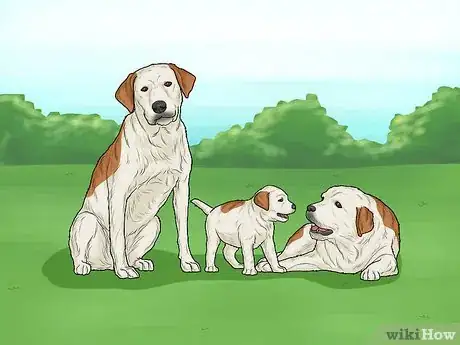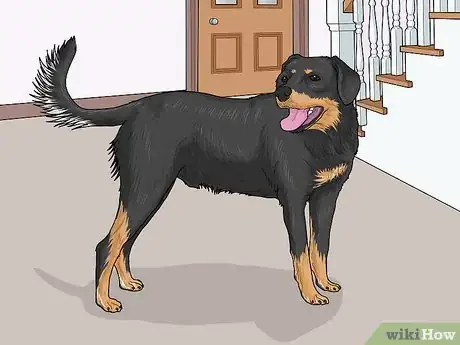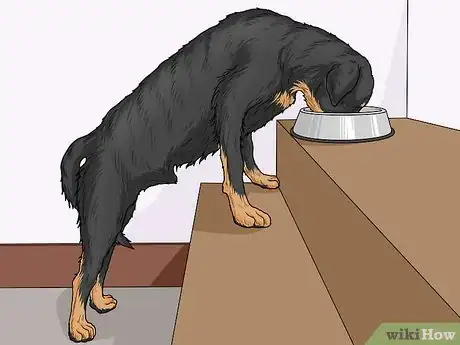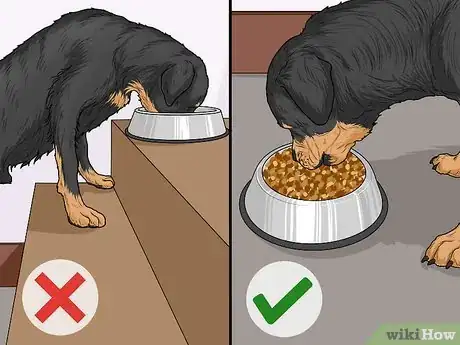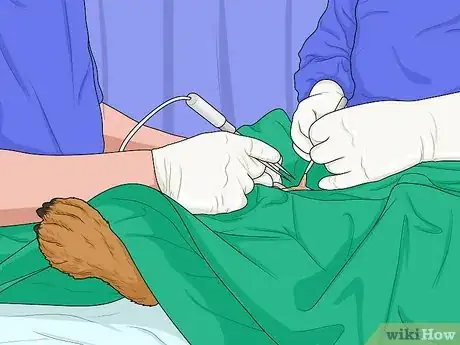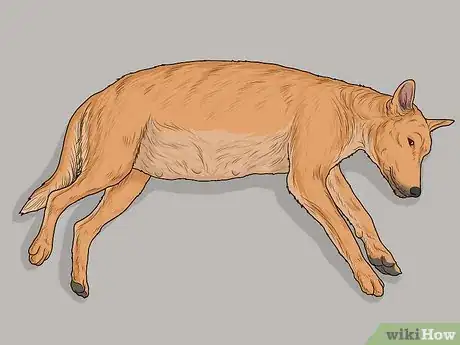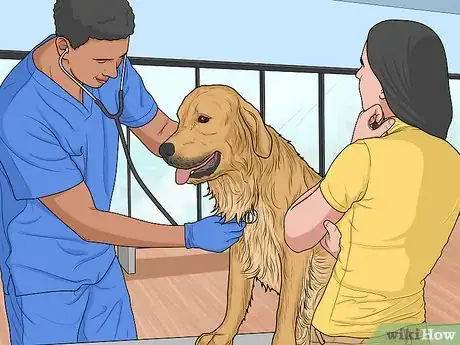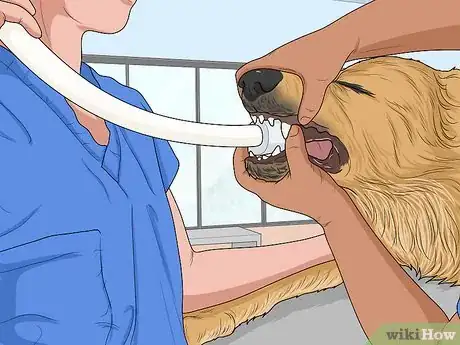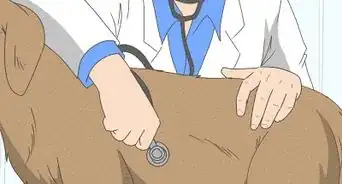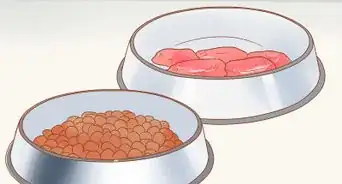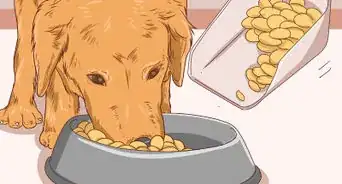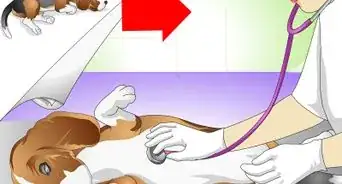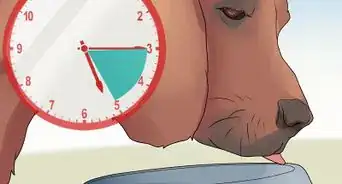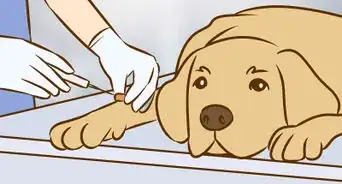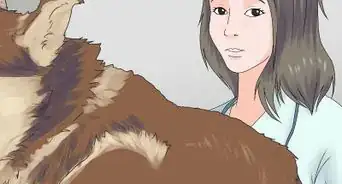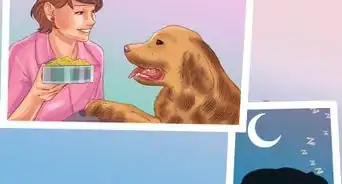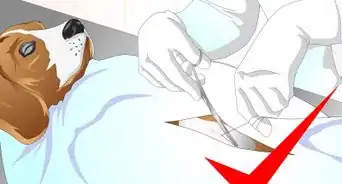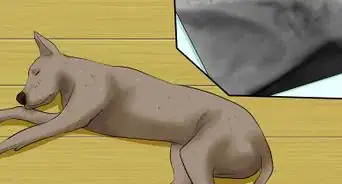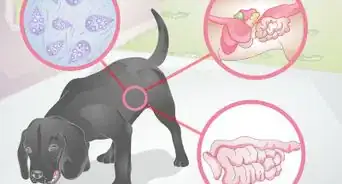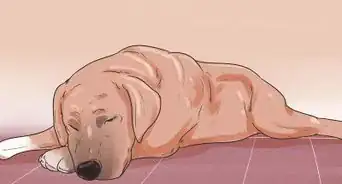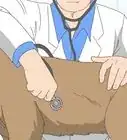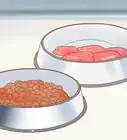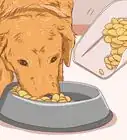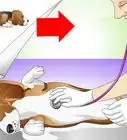This article was co-authored by Ray Spragley, DVM. Dr. Ray Spragley is a Doctor of Veterinary Medicine and the Owner/Founder of Zen Dog Veterinary Care PLLC in New York. With experience in multiple institutions and private practices, Dr. Spragley’s specializations and interests include non-surgical management of cranial cruciate ligament tears, Intervertebral Disk Disease(IVDD), and pain management in osteoarthritis. Dr. Spragley holds a BS in Biology from SUNY Albany and has a Doctor of Veterinary Medicine degree (DVM) from Ross University School of Veterinary Medicine. He is also a Certified Canine Rehabilitation Therapist (CCRT) through the Canine Rehab Institute as well as a Certified Veterinary Acupuncturist (CVA) through Chi University.
There are 8 references cited in this article, which can be found at the bottom of the page.
This article has been viewed 24,288 times.
Bloat in dogs is a very serious medical condition that should be treated as an emergency. The technical name for bloat is gastric dilation and volvulus syndrome (GDV) and it occurs when the stomach dilates or expands with fluid and gas. Once the stomach expands the problems increase, as the stomach twists and rotates around its short axis.[1] GDV needs to be treated quickly, as the twisting action can irreparably damage the body tissues, leading to death.
Steps
Assessing and Lowering Your Dog's Risk of Bloat
-
1Assess genetic risk factors. We are not entirely certain why bloat occurs but we do know that it can run in families. Determine your dogs relatives (littermate, parents) have had bloat. If they have, then your dog has a higher risk of getting it.[2]
-
2Determine if your dog has a build that would boost its chances of getting bloat. Middle-aged and older large and giant breed dogs are more likely to experience bloat. Most of these dogs have a deep chest and a thin body frame. These physical traits can contribute to the incidence of bloat.[3]Advertisement
-
3Evaluate whether your dog's eating habits will increase its likelihood of getting bloat. How your dog eats will influence its risk of getting bloat. Feeding habits that can increase the likelihood of bloat include: [4]
- Feeding a dog from a raised bowl.
- Feeding a large amount of food or water at one time or over time.
- Once a day feeding.
- Vigorous exercise around feeding time.
- Rapid eating of food which means more air in the stomach.
- Conditions in which the outflow of food from the stomach is slowed or impeded.
- Feeding dry foods with a high oil or fat content.
-
4Eliminate risk factors. While there are some factors you cannot change, such as the genetics and the build of your dog, there are some things you can do to lessen the risk of your dog getting bloat. Researchers at Purdue University performed a major study on bloat in dogs.[5] Study results determined that there were some steps that dog owners can do to help prevent bloat. These steps are:
- Divide the food into two or more smaller servings a day.
- Do not feed from a raised bowl. Feed from a bowl on the ground.
- Make sure that fat isn’t in the top four ingredients of the food you feed your dog.
- Do not feed an all dry food diet. Include wet foods or large meat chunks in the diet.
- Do not moisten dry food.
- Wait one hour before feeding and two hours after eating before letting your dog exercise or before going for walks, etc.[6]
- For dry food, feed no more than one cup per thirty pounds of body weight per meal (divided between at least two meals).
- If your dog is a greedy eater and gulps its food, invest in a food dish that forces the dog to eat slower, such as the slow feeder or fun feeder.
-
5Consider preventative surgery. Discuss with your veterinarian if your dog would be a good candidate for a precautionary gastropexy. Military service dogs (large breeds like German shepherd and Belgian Malinois) are frequently given a precautionary gastropexy to avoid any emergency situations when they are on the battlefield.[7] However, most owners opt to monitor their large and giant breed dogs instead of taking this measure.
Diagnosing and Treating Bloat
-
1Keep a look out for symptoms of bloat. The signs of bloat usually come on rapidly. These include:[8]
- Pacing and restlessness
- Excessive salivation
- Enlarged abdomen (belly)[9]
- Reluctance or inability to stand or walk.
- Rapid or weak pulse
- Pale gums
- Retching or dry heaving without bringing anything up. The esophagus is involved in the twist so nothing can come back through the mouth.
-
2Take your dog to a veterinarian immediately if you see the symptoms of bloat. Keep in mind that this is a medical emergency and the dog needs to be taken to the veterinarian as soon as possible if bloat is suspected.[10] Dogs can die soon after the signs appear due to damage done to internal organs, collapse of the circulatory system, toxin buildup, and shock.
- A dog that is brought into the veterinarian’s office is first given a physical examination and blood is checked for responses to internal organ damage. Radiographs (X-rays) are generally taken, which will show the bloated stomach along with the twist in the stomach.
- In some cases a needle is advanced into the abdominal cavity and suction is applied to the syringe. This is done to determine if the stomach has ruptured, an unfortunate outcome in some cases of bloat.
-
3Get bloat treated. A tube may be passed through the dog’s mouth and into the stomach to relieve the pressure of air buildup. Occasionally a tube will be placed directly through the skin and muscle into the stomach to relieve the pressure in the stomach. An intravenous (IV) line will be placed in a vein to provide medications and fluids.[11]
- The treatment of bloat is surgery to untwist the stomach and to suture part of the stomach to the inside of the abdomen wall to prevent it from recurring. This is called a gastropexy. If the stomach ruptured the stomach will be repaired and the internal abdomen will be flushed.
- Dogs will be closely monitored after surgery. Generally the dog will be placed on antibiotics and pain killers before and after surgery. Depending on your veterinarian clinic and how intensive the surgery was, the dog will need to remain hospitalized for up to 7 days.
- Sadly up to 15% of dogs with gastric dilation and volvulus do not survive surgery despite the skill of the veterinarian.[12]
Expert Q&A
-
QuestionIs a gastropexy worth it?
 Ray Spragley, DVMDr. Ray Spragley is a Doctor of Veterinary Medicine and the Owner/Founder of Zen Dog Veterinary Care PLLC in New York. With experience in multiple institutions and private practices, Dr. Spragley’s specializations and interests include non-surgical management of cranial cruciate ligament tears, Intervertebral Disk Disease(IVDD), and pain management in osteoarthritis. Dr. Spragley holds a BS in Biology from SUNY Albany and has a Doctor of Veterinary Medicine degree (DVM) from Ross University School of Veterinary Medicine. He is also a Certified Canine Rehabilitation Therapist (CCRT) through the Canine Rehab Institute as well as a Certified Veterinary Acupuncturist (CVA) through Chi University.
Ray Spragley, DVMDr. Ray Spragley is a Doctor of Veterinary Medicine and the Owner/Founder of Zen Dog Veterinary Care PLLC in New York. With experience in multiple institutions and private practices, Dr. Spragley’s specializations and interests include non-surgical management of cranial cruciate ligament tears, Intervertebral Disk Disease(IVDD), and pain management in osteoarthritis. Dr. Spragley holds a BS in Biology from SUNY Albany and has a Doctor of Veterinary Medicine degree (DVM) from Ross University School of Veterinary Medicine. He is also a Certified Canine Rehabilitation Therapist (CCRT) through the Canine Rehab Institute as well as a Certified Veterinary Acupuncturist (CVA) through Chi University.
Veterinarian It can be, especially if your dog is physically or genetically more likely to get bloat. A gastropexy makes sure that the stomach cannot twist in the stomach, which prevents bloat.
It can be, especially if your dog is physically or genetically more likely to get bloat. A gastropexy makes sure that the stomach cannot twist in the stomach, which prevents bloat. -
QuestionWhat causes a dog to bloat?
 Ray Spragley, DVMDr. Ray Spragley is a Doctor of Veterinary Medicine and the Owner/Founder of Zen Dog Veterinary Care PLLC in New York. With experience in multiple institutions and private practices, Dr. Spragley’s specializations and interests include non-surgical management of cranial cruciate ligament tears, Intervertebral Disk Disease(IVDD), and pain management in osteoarthritis. Dr. Spragley holds a BS in Biology from SUNY Albany and has a Doctor of Veterinary Medicine degree (DVM) from Ross University School of Veterinary Medicine. He is also a Certified Canine Rehabilitation Therapist (CCRT) through the Canine Rehab Institute as well as a Certified Veterinary Acupuncturist (CVA) through Chi University.
Ray Spragley, DVMDr. Ray Spragley is a Doctor of Veterinary Medicine and the Owner/Founder of Zen Dog Veterinary Care PLLC in New York. With experience in multiple institutions and private practices, Dr. Spragley’s specializations and interests include non-surgical management of cranial cruciate ligament tears, Intervertebral Disk Disease(IVDD), and pain management in osteoarthritis. Dr. Spragley holds a BS in Biology from SUNY Albany and has a Doctor of Veterinary Medicine degree (DVM) from Ross University School of Veterinary Medicine. He is also a Certified Canine Rehabilitation Therapist (CCRT) through the Canine Rehab Institute as well as a Certified Veterinary Acupuncturist (CVA) through Chi University.
Veterinarian Overeating, rapid eating drinking and eating, and exercising after eating can lead to bloat.
Overeating, rapid eating drinking and eating, and exercising after eating can lead to bloat.
Warnings
- Never leave a large or giant breed of dog unattended for the 2-3 hours after eating. Wait to feed the dog when you will be around to watch it and monitor its physical activity.⧼thumbs_response⧽
References
- ↑ http://www.petmd.com/dog/conditions/digestive/c_dg_gastric_dilation_volvulus_syndrome
- ↑ Small Animal Practice Client Handouts. Rhea V. Morgan. Elsevier Health Sciences. 2010
- ↑ Ray Spragley, DVM. Veterinarian. Expert Interview. 19 August 2021.
- ↑ http://www.petmd.com/dog/conditions/digestive/c_dg_gastric_dilation_volvulus_syndrome?page=2
- ↑ http://www.instituteofcaninebiology.org/bloat-purdue-study.html
- ↑ Ray Spragley, DVM. Veterinarian. Expert Interview. 19 August 2021.
- ↑ http://www.pacaf.af.mil/News/ArticleDisplay/tabid/377/Article/594871/kadena-vet-clinic-keeps-military-working-dogs-in-top-shape.aspx
- ↑ Handbook of Small Animal Gastroenterology. Todd R. Tams. Elsevier Health Sciences. 2003
- ↑ Ray Spragley, DVM. Veterinarian. Expert Interview. 19 August 2021.
- ↑ Ray Spragley, DVM. Veterinarian. Expert Interview. 19 August 2021.
- ↑ Textbook of Small Animal Surgery, Volume 1. Douglas H. Slatter. Elsevier Health Sciences. 2003
- ↑ http://www.instituteofcaninebiology.org/bloat-purdue-study.html
About This Article
One way to prevent bloating in your dog is to spread out its food and water intake throughout the day so it’s not eating and drinking too much at once. You should also avoid feeding your dog dry foods that have a high quantity of oil and fat, which can cause bloating. Additionally, if you usually take your dog for a walk right after dinner, try changing up your routine so your dog has more time to digest its food before exercising and doesn’t get bloated. To learn how to recognize symptoms of bloating in your dog, read more from our Veterinarian co-author.
